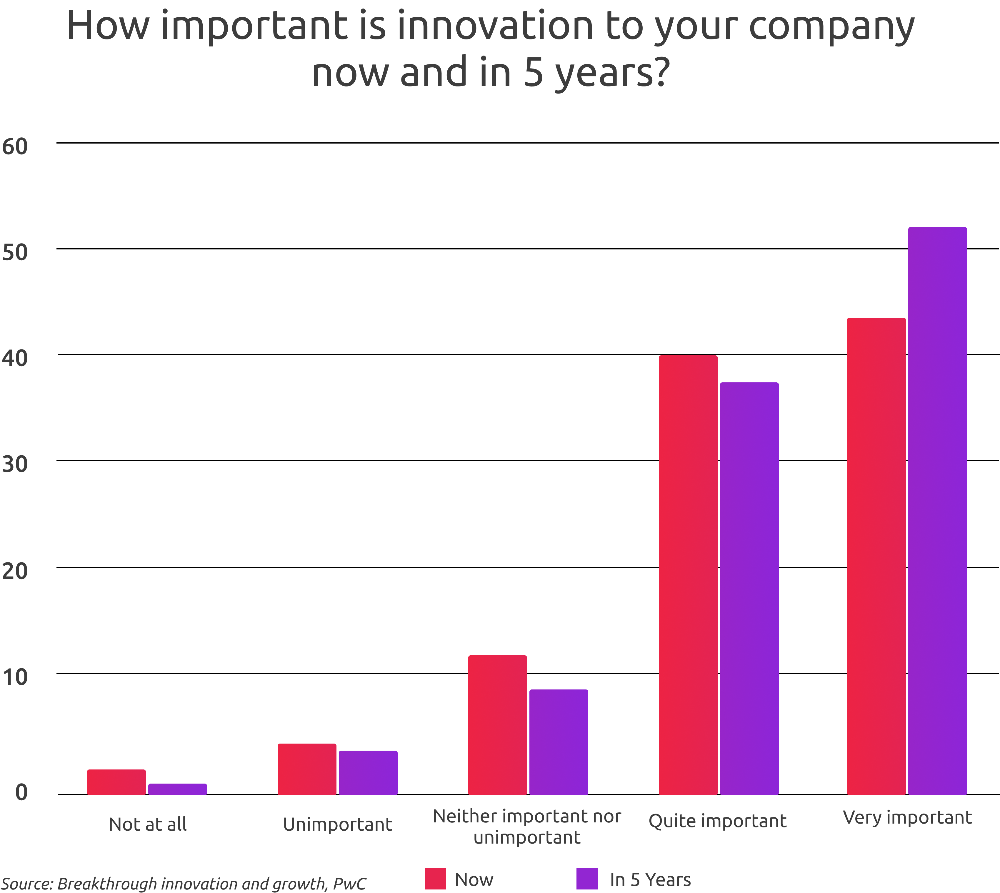The cost of not innovating in an era of digital transformation
In an evolving business landscape, digital transformation is no longer a choice, but a necessity. This holds true even for the oil & gas sector, where embracing technological advancements is crucial.
Failing to digitize your operations puts your company at risk of falling behind more proactive and agile competitors.
PwC interviewed both small and big companies in the oil and gas supply chain regarding the importance of innovation in the digital age, and here are their findings:

Of the companies that participated in the interview, around four-fifths of the respondents cited digital innovation as an important aspect of their business.
As many as 39 % of the interviewed executives said that innovation is already a competitive necessity in their business, while 48% suggested that innovation will be vital for every area of the industry in the next 5 years.
However, about half of the companies say that they have a well-laid-out innovation strategy that they are working on.
This comes as no surprise considering the major shift we saw during the Covid-19 pandemic when a large percentage of companies across all sectors had to re-orient themselves to stay relevant.
This begs the question, what do oil and gas companies that do not have a digital innovation strategy stand to lose?
Read on for a comprehensive look at the dangers of not innovating in a digital transformation era, and why.
The dangers of not innovating in digital transformation in the oil & gas sector
Reduced productivity levels
New technologies and innovations play an important role in increasing an organization's productivity levels.
In the oil and gas sector, they have the potential to increase the contribution of labour and capital to organizational workflows, thus boosting productivity. [1]
Essentially, employees work faster and more efficiently when provided with the necessary digital technologies. It also gives them more time to focus on other critical value-addition tasks.
For instance, by automating administrative tasks through software, your employees are better able to attend to more demanding duties.
Conversely, employees' productivity levels drop significantly without the proper tools they need to accomplish their tasks.
This means that any company that fails to embrace digitalization faces lower work efficiency and employee dissatisfaction.
Loss of competitive advantage
Today's customers don't just want high-quality products and services; they also expect an exceptional digital experience. [2]
This is why companies would want to make the digital experience an integral part of their overall customer experience, especially since 70% of all customer interactions are now in the digital space. [3]
By providing a good digital experience, you don't just satisfy the needs of your customers, you turn first-time customers into lifelong clients and boost your brand's image. Likewise, failure to adopt and innovate in digitization can cost you sales. In fact, a recent survey reveals that at least 64% of customers have taken their business to competitors due to poor customer service. [4]
The risk of losing out on top talent
Conventional, rigid infrastructures are no longer favourable to workers. Nowadays, workers are increasingly gravitating towards working environments that include flexible and remote working arrangements.
As such, organizations must implement technologies like automation, collaboration tools, and artificial intelligence to achieve this level of flexibility for their workers.
Any organization that fails to meet the requirements for a conducive working environment risks losing some of its top employees and may have difficulty recruiting.
Ensuring your team members have the best tools for their roles should be a top priority, complementing their skills and enhancing productivity.
Reduced revenue
Despite their seemingly steep cost, innovation and digital transformation efforts may help businesses save on infrastructure and running costs in the long run.
Digital transformation solutions can also help companies restructure and transform their operations to maximize profits while reducing operational costs.
For instance, technologies like robotics automation, artificial intelligence, and machine learning can improve productivity and performance, and simplify any business process.
Similarly, legacy technologies present a lot of inefficiencies and often require a lot of resources to maintain.
For instance, a company relying on an on-premises server infrastructure needs to maintain a dedicated IT team to manage the system.
However, since IT management might not align with the company's core competencies, leveraging cloud-based infrastructures would allow the business to focus more on its core strengths while leaving IT responsibilities to specialized cloud service providers.
This strategic move can lead to improved efficiency and resource allocation, empowering the company to concentrate on its primary expertise and overall business growth.
Stunted business growth
Just because a company doesn't want to invest in new technologies doesn't mean its competitors won't.
And about implementing new technologies, early adopters often have a learning advantage. They are also better equipped to adapt to environmental trends faster than their competitors.
With time, businesses that transition faster become more relevant as consumers go with the trends, leaving the other ones behind.
This causes a huge bridge that oil and gas companies still relying on legacy technology might have a hard time crossing, especially if it means changing their service delivery to meet market demands.
Balance innovation and operational stability
Finding the perfect equilibrium between innovation and operational stability can be challenging, but it's vital for the long-term success of your business. Here are several ways you can balance innovation and operational stability in your business:
Formalize your process
Before you get to balance, you first need to create a framework for innovation in the organization. This involves everything from establishing clear rules and standards to be followed during innovation to ensuring that all new ideas are thoroughly evaluated before implementation.
Contract experts for niche processes
You should be open to contracting certain duties. For instance, if you're building software, contracting a third-party team can free up your in-house team, enabling them to focus on other important issues. This can also bring value to your business through specialized expertise and technologies that may not be available in your organization.
Focus on agile development
Digital change doesn't just happen overnight. It is a slow, incremental process involving continuous feedback and collaboration between different teams to achieve your goals.
Focus on user needs
What do your customers need?
You can't innovate for the sake of innovating. You must ensure that you prioritize the features and technologies most relevant to your intended users' needs. You should also ensure that your priorities align with your overall business strategy.
Familiarize your team with the new technologies
Successful digital transformation doesn't end with innovating and implementing new technologies.
You also have to ensure that your team can operate, monitor, and respond to any issues with the new technology.
This way, you'll be better able to leverage all implemented technologies and cut costs associated with technical support and maintenance.
Wrapping up
The cost of innovating can be staggering, but failure to embrace digital transformation can render any business obsolete.
Moreover, innovating in digital transformation has numerous benefits, including growth, market differentiation, and enhanced customer satisfaction.
That said, innovation must align with the business's operational stability and overall objectives to keep the business successful.
Sources
[1] One.oecd.com, The impact of digitalisation on productivity.
[2] Mediapost.com, Consumers Depend On Digital Services, But Are Easily Frustrated, Study Finds.
[3] zdnet. com, 70% of customer interactions are now digital and most companies are not ready
[4] Businesswire.com, New Survey Reveals 64 Percent of Consumers Have Jumped to a Competitor Following a Poor Customer Experience
Share this
You May Also Like
These Related Stories

Bridging the gap between legacy systems and digital innovation

The Playbook: Driving digital transformation at medium-large enterprises
